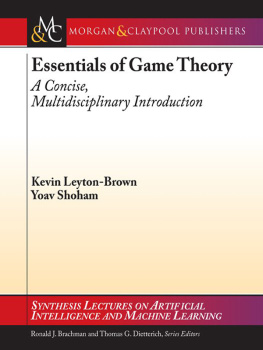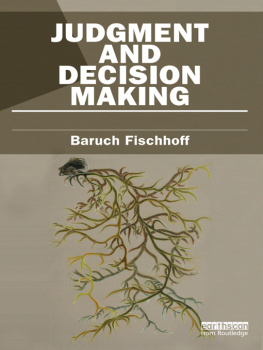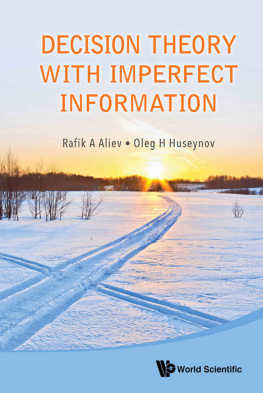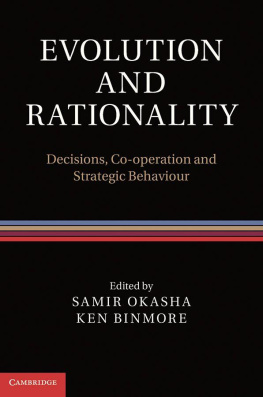An Introduction to Decision Theory
This up-to-date introduction to decision theory offers comprehensive and accessible discussions of decision making under ignorance and risk, the foundations of utility theory, the debate over subjective and objective probability, Bayesianism, causal decision theory, game theory and social choice theory. No mathematical skills are assumed, and all concepts and results are explained in non-technical and intuitive as well as more formal ways. There are over 100 exercises with solutions, and a glossary of key terms and concepts. An emphasis on foundational aspects of normative decision theory (rather than descriptive decision theory) makes the book particularly useful for philosophy students, but it will appeal to readers in a range of disciplines including economics, psychology, political science and computer science.
MARTIN PETERSON is Associate Professor of Philosophy at the Royal Institute of Technology, Sweden. He is author of Non-Bayesian Decision Theory (2008).
CAMBRIDGE UNIVERSITY PRESS
Cambridge, New York, Melbourne, Madrid, Cape Town, Singapore, So Paulo, Delhi
Cambridge University Press
The Edinburgh Building, Cambridge CB2 8RU, UK
Published in the United States of America by Cambridge University Press, New York
www.cambridge.org
Information on this title: www.cambridge.org/9780521716543
Martin Peterson 2009
This publication is in copyright. Subject to statutory exception and to the provisions of relevant collective licensing agreements, no reproduction of any part may take place without the written permission of Cambridge University Press.
First published 2009
Printed in the United Kingdom at the University Press, Cambridge
A catalogue record for this publication is available from the British Library
ISBN 978-0-521-88837-0 hardback
ISBN 978-0-521-71654-3 paperback
Cambridge University Press has no responsibility for the persistence or accuracy of URLs for external or third-party internet websites referred to in this book, and does not guarantee that any content on such websites is, or will remain, accurate or appropriate.
Preface
This book is an introduction to decision theory. My ambition is to present the subject in a way that is accessible to readers with a background in a wide range of disciplines, such as philosophy, economics, psychology, political science and computer science. That said, I am myself a philosopher, so it is hardly surprising that I have chosen to discuss philosophical and foundational aspects of decision theory in some detail. In my experience, readers interested in specific applications of the subject may find it helpful to start with a thorough discussion of the basic principles before moving on to their chosen field of specialisation.
My ambition is to explain everything in a way that is accessible to everyone, including readers with limited knowledge of mathematics. I therefore do my best to emphasise the intuitive ideas underlying the technical concepts and results before I state them in a more formal vocabulary. This means that some points are made twice, first in a non-technical manner and thereafter in more rigorous ways. I think it is important that students of decision theory learn quite a bit about the technical results of the subject, but most of those results can no doubt be explained much better than what is usually offered in textbooks. I have tried to include only theorems and proofs that are absolutely essential, and I have made an effort to prove the theorems in ways I believe are accessible for beginners. In my experience, this sometimes comes into conflict with the ambition to present technical material in the minimalist style usually preferred by experts.
Most of the technical results are presented in twenty boxes clearly separated from the main body of the text. In principle, it should be possible to read the book without reading the boxes, although they hopefully deepen the students understanding of the subject. I have also included over 100 exercises (and solutions), most of which should be fairly straightforward. Unlike other textbooks, no exercise asks the reader to prove some theorem I did not bother to prove myself. Finally, Appendix A contains a glossary in which I try to briefly explain some of the key terms and concepts. I believe the glossary might be particularly useful for readers wishing to study only a selected number of the chapters.
A large number of people deserve my sincere thanks. First of all, I would like to thank all students who have contributed their invaluable input to this project. I have done my best to improve the manuscript in accordance with the advice I have received. I am also deeply indebted to a number of fellow teachers and colleagues: Barbro Bjrkman, Joanna Burch Brown, John Cantwell, Stephen John, Elselijn Kingma, Holger Rosencrantz, and Per Sandin. I am also very grateful for valuable comments on the original proposal and draft manuscript given by four anonymous readers. Finally, I wish to thank Hilary Gaskin at Cambridge University Press, who suggested I should write this textbook. Without her enthusiasm and encouragement, this book would never have been written. The project proved to be both challenging and time consuming but always highly enjoyable.
Introduction
On 6 September 1492 Christopher Columbus set off from the Canary Islands and sailed westward in an attempt to find a new trade route between Europe and the Far East. On 12 October, after five weeks of sailing across the Atlantic, land was sighted. Columbus had never been to the Far East, so when he landed in Middle America (the West Indies) he believed that he had indeed discovered a new route to the Far East. Not until twenty-nine years later did Magellan finally discover the westward route to the Far East by sailing south around South America.
Columbus decision to sail west from the Canary Islands was arguably one of the bravest decisions ever made by an explorer. But was it rational? Unlike some of his contemporaries, Columbus believed that the Earth is a rather small sphere. Based on his geographical assumptions, he estimated the distance from Europe to East India to total 2,300 miles. The actual distance is about 12,200 miles, which is more than five times farther than Columbus thought. In the fifteenth century no ship would have been able to carry provisions for such a long journey. Had America not existed, or had the Earth been flat, Columbus would certainly have faced a painful death. Was it really worth risking everything for the sake of finding a new trade route?
This book is about decision theory. Decision theory is the theory of rational decision making. Columbus decision to set off westwards across an unknown ocean serves as a fascinating illustration of what decision theory is all about. A decision maker , in this case Columbus, chooses an act from a set of alternatives , such as sailing westwards or staying at home. The outcome depends on the true state of the world , which in many cases is only partially known to the decision maker. For example, had the Earth been a modest-sized sphere mostly covered by land and a relatively small and navigable sea, Columbus decision to sail westwards would have made him rich and famous, because the King and Queen of Spain had promised him ten per cent of all revenue gained from a new trade route. However, Columbus geographical hypothesis turned out to be false. Although spherical, the Earth is much bigger than Columbus assumed, and Europe is separated from the Far East by a huge continent called America. Thus, in the fifteenth century the westward route was not a viable option for Europeans wishing to trade with the Far East. All this was unknown to Columbus. Despite this, the actual outcome of Columbus decision was surprisingly good. When he returned to Spain he gained instant fame (though no financial reward). Another possible outcome would have been to never reach land again. Indeed, a terrible way to die!











